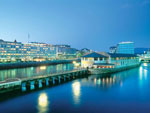 The majority of sights of the Red Square appeared in 16-19th centuries, and Lenin’s Mausoleum is the only monument of the 20th century. The Lenin's Mausoleum is a resting place of Vladimir Ilich Lenin, the leader of October Revolution and the founder of the USSR.
The majority of sights of the Red Square appeared in 16-19th centuries, and Lenin’s Mausoleum is the only monument of the 20th century. The Lenin's Mausoleum is a resting place of Vladimir Ilich Lenin, the leader of October Revolution and the founder of the USSR.
In 1923 health of the leader of the Soviet State reeled, treatment did not help, and he suddenly died on 21 January 1924. Thousands of people came to say final goodbyes, so the government soon made the decision to build a mausoleum, so that others would have time to say goodbye later. The wooden mausoleum was ready by 27 January.
It was the first version developed by an architect Shchusev. The mausoleum had the form of a cube crowned with a three-stage pyramid. Several months later, the second wooden mausoleum , a copy of the first one but with tribunes, was built. The embalmed Lenin’s body was placed in a specially made sarcophagus.
In 1929-1930, the designer of first two mausoleums, architect Schusev designed and constructed the third mausoleum located on the Red Square today. Marble, porphyry, granite, labradorite, and other construction materials were used. This mausoleum kept the general concept of the first versions, and also had tribunes where governors and figures of Soviet Union acted.
The year 1941 marked the beginning of the World War II. There was a fight for Moscow, and Lenin’s body was evacuated to Tyumen (Siberia). Only by the end of war, in April 1945, a body of the leader was returned to the mausoleum. Stalin died in 1953, and his body also was embalmed and placed in the Mausoleum which was called now ‘V.I.Lenin and I.V.Stalin's Mausoleum’. But in 1961, after a dethronement of the cult of personality, Stalin's body was buried. At the same time there was a decision about the transportation of bodies of leaders to the Pantheon and mausoleum dismantle, but it never came into force.
 Surprisingly, as far back as the Soviet epoch there were opponents of a mode who made the protest attempt to profane Lenin's body. Totally, there were over 10 attempts to damage the Mausoleum for 70 years of the existence of Soviet Union. They tried to shot at Lenin’s body, threw stones, hammers and bottles with an incendiary mix, there was even an explosion case. But the body of the leader was damaged only once: it was damaged by pieces of glass. In 1973, a special bulletproof sarcophagus was established in the museum.
Surprisingly, as far back as the Soviet epoch there were opponents of a mode who made the protest attempt to profane Lenin's body. Totally, there were over 10 attempts to damage the Mausoleum for 70 years of the existence of Soviet Union. They tried to shot at Lenin’s body, threw stones, hammers and bottles with an incendiary mix, there was even an explosion case. But the body of the leader was damaged only once: it was damaged by pieces of glass. In 1973, a special bulletproof sarcophagus was established in the museum.
In 1990s , after disintegration of the USSR, the question on liquidation of the Mausoleum and Lenin's burial place was brought up again, but the government decided that it was an epoch symbol in which millions people trusted, and that its destruction would be a blasphemy. So, the mausoleum will stand still for a long time on the Red Square at walls of the Kremlin.
Nowadays, the Mausoleum is opened for visiting, but only in certain days. It is forbidden to bring any means of a photo and a video shooting, and also various bags, backpacks, large metal subjects and bottles with a liquid.
Certainly, it will be finally dismantled sometime in the future, Lenin's body will be buried at last, but now the Mausoleum is the main symbol of the past epoch, a communism epoch. And that fact that people come to the mausoleum to look, and some and to bow to the leader of proletariat, is an evidence that this monument is important for Moscow and Russia.







